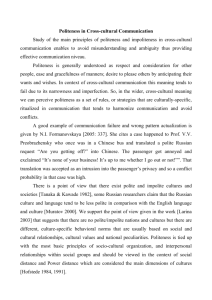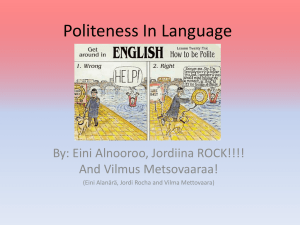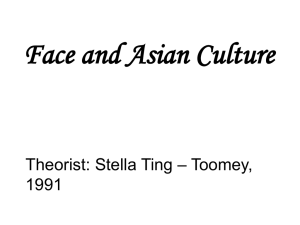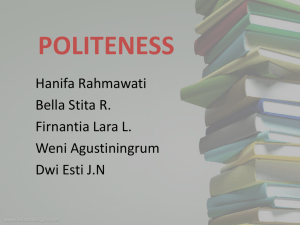POLITENESS AND INTERACTION Ella Wulandari, M.A.
advertisement
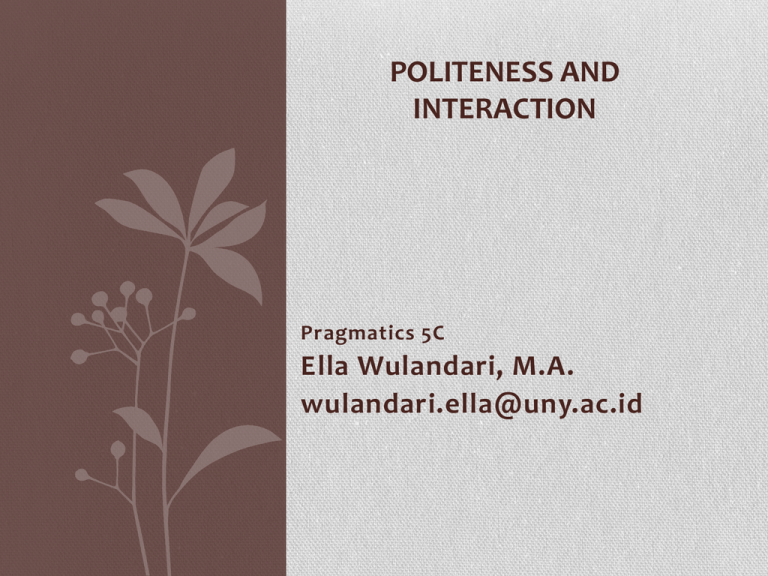
POLITENESS AND INTERACTION Pragmatics 5C Ella Wulandari, M.A. wulandari.ella@uny.ac.id Things to discuss: • Politeness • Face wants • Negative and positive face • Self and other: say nothing • Say something: off and on record • Positive and negative politeness • Strategies • Pre-sequences Why do we need to learn it? • Linguistic interaction = a social interaction. • For interaction to be successful (i.e. what is said is understood) the interactants need to consider and (sometimes) negotiate factors related to social distance and closeness. • External & internal factors • Social distance an external factor (determined prior to the interaction (as being known to both interactants).) power, age, ‘being a Haji/Hajjah’, ‘Ustadz/Ustadzah’? e.g. Title + last name • Closeness an internal factor (negotiated during the interaction) degree of friendliness/familiarity E.g. First name Politeness • the means employed to show awareness of another person’s face. • Face: the public self-image of a person • Politeness associated & marked linguistically with the assumption of relative social distance and closeness. • Face wants: people’s expectation concerning their public self-image. • Face-threatening act: • Face-saving act: • E.g. Politeness strategies: Negative and Positive Faces & Off and On record • Negative face the need of to be independent, freedom of action and free of other’s imposition negative politeness • Positive face the need to be accepted, even to be liked by others, to be treated as a member of the same group, and to know his or her wants are shared by others (‘to be connected’) positive politeness • Say or not to say • Off record • On record • Bald on record Bald on record & migitigating device • Bald on record often happen when the speaker assumes to have power/control over the other (military) & can control the other’s behavior with words. • Mitigating devices to soften ‘the bald on record’ by using ‘please’ or ‘would you like to’. • Negative politeness deference strategy • Positive politeness solidarity strategy Pre-sequences • Pre-request • Pre invitation • Pre announcement • Pre sequences project specific next activity and precede a particular base sequence • •They are used to project actions such as pre invitations, pre offers, pre request sequences • •Preliminaries: pre-sequences that project first pair part and make relevant a second pair part • •They have a specific structure • •Pre-invitations:“are you doing anything tonight? • •Pre –requests: “have you got X?” • • • • • • • • • • 1 Allen: Hello? •2 John: Yeah, is Judy there? •3 Allen: Yeah, just a second. •4 ((silence)) •5 Judy: Hello, •6 John: Judy? •7 Judy: Yeah, •8 John: John Smith. •9 Judy: Hi John. •10 John:-> Ha you doin-<say what ‘r you doing. • •11 Judy:-> Well, we’re going out. Examples • Pre invitations: go ahead, blocking or hedging • •They are question answer sequences • •It is done by the inviter to determine availability of invitee • •They are used to avoid for the invitee having to do a dispreferred action • Prerequest can sometimes achieve the request • •Have you got Malboro Lights please? • •Yes dear (provides) • •(brand of cigarettes) • •Prerequest can be followed by offer • •A: Do you have a pecan Danish today? • •B: Yes we do. Would you like one of those? • •C: Yes please • •D: okay Pre- announcement & pre-offer • a) they serve as an alert to recipients that what is to follow is built to be an informing or a telling of news; • •b) they may offer a characterization or assessment of the news (good/bad news) or a permeation of the topic which helps recipient’s recognition; • •c) they may give evidence of the recency of what is to be reported • •d) they make the actual telling a contingent next step by formulating it as an offer or request to tell (“Y’wanna know who...”) (Schegloff, 1995) • They are used as go ahead or blocking offers in the same way as invitations • •N: so:: have you got a lift? • •J: yeah. I’m going with Jodie. • •N: Ok


